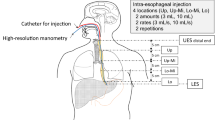Abstract
The development of a solid-state intraluminal sphincter transducer has alleviated many of the problems associated with manometric studies of the upper esophageal sphincter (UES) and pharynx (P). We used this technology to study the effect of position (upright vs. supine) on resting UES pressures and the pressure dynamics of the UES/P complex during both wet and dry swallows in 11 normal volunteers and the effects of foods of different consistencies on the UES/P swallow dynamics in 10 normal volunteers. The UES/P coordination parameters were defined as the 15 time intervals that can be measured between any 2 of 6 pertinent points: the beginning, peak, and end of the pharyngeal contraction and the beginning, nadir, and end of the UES relaxation. Data from both the circumferential transducer used to measure sphincter pressures and a standard microtransducer used to measure pharyngeal pressures were collected on-line by an Apple IIe microcomputer and analyzed by programs written in our laboratory. Significant changes in swallow coordination were measured between upright and supine swallows of the same bolus size, between wet and dry swallows in the same position, and among foods of varying consistencies. Resting UES pressure was unchanged by position and pharyngeal contraction pressure was unchanged by bolus size or consistency.
Similar content being viewed by others
References
Castell JA, Dalton CB, Castell DO: Pharyngeal and upper esophageal manometry in humans.Am J Physiol 258:G173-G178, 1990
Castell JA, Castell DO: Computer analysis of human esophageal peristalsis and lower esophageal sphincter pressure II. An interactive system for on-line data collection and analysis.Dig Dis Sci 31:1211–1216, 1986
Castell JA, Dalton CB, Castell DO: On-line computer analysis of human lower esophageal sphincter relaxation.Am J Physiol 255:G794-G799, 1988
Kahrilas PJ, Dent J, Dodds WJ, Hogan WJ, Arndofer RC: A method for continuous monitoring of upper esophageal sphincter pressure.Dig Dis Sci 32:121–128, 1987
Kahrilas PJ, Dodds WJ, Dent J, Logemann J, Shaker R: Upper esophageal sphincter function during deglutition.Gastroenterology 95:52–62, 1988
Author information
Authors and Affiliations
Rights and permissions
About this article
Cite this article
Castell, J.A., Dalton, C.B. & Castell, D.O. Effects of body position and bolus consistency on the manometric parameters and coordination of the upper esophageal sphincter and pharynx. Dysphagia 5, 179–186 (1990). https://doi.org/10.1007/BF02412685
Issue Date:
DOI: https://doi.org/10.1007/BF02412685




